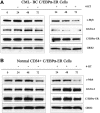Transcriptional repression of c-Myb and GATA-2 is involved in the biologic effects of C/EBPalpha in p210BCR/ABL-expressing cells
- PMID: 18550858
- PMCID: PMC2518896
- DOI: 10.1182/blood-2007-09-114975
Transcriptional repression of c-Myb and GATA-2 is involved in the biologic effects of C/EBPalpha in p210BCR/ABL-expressing cells
Abstract
Ectopic C/EBPalpha expression in p210(BCR/ABL)-expressing hematopoietic cells induces granulocytic differentiation, inhibits proliferation, and suppresses leukemogenesis. To assess the underlying mechanisms, C/EBPalpha targets were identified by microarray analyses. Upon C/EBPalpha activation, expression of c-Myb and GATA-2 was repressed in 32D-BCR/ABL, K562, and chronic myelogenous leukemia (CML) blast crisis (BC) primary cells but only c-Myb levels decreased slightly in CD34(+) normal progenitors. The role of these 2 genes for the effects of C/EBPalpha was assessed by perturbing their expression in K562 cells. Ectopic c-Myb expression blocked the proliferation inhibition- and differentiation-inducing effects of C/EBPalpha, whereas c-Myb siRNA treatment enhanced C/EBPalpha-mediated proliferation inhibition and induced changes in gene expression indicative of monocytic differentiation. Ectopic GATA-2 expression suppressed the proliferation inhibitory effect of C/EBPalpha but blocked in part the effect on differentiation; GATA-2 siRNA treatment had no effects on C/EBPalpha induction of differentiation but inhibited proliferation of K562 cells, alone or upon C/EBPalpha activation. In summary, the effects of C/EBPalpha in p210(BCR/ABL)-expressing cells depend, in part, on transcriptional repression of c-Myb and GATA-2. Since perturbation of c-Myb and GATA-2 expression has nonidentical consequences for proliferation and differentiation of K562 cells, the effects of C/EBPalpha appear to involve dif-ferent transcription-regulated targets.
Figures








References
-
- Keeshan K, Santilli G, Corradini F, Perrotti D, Calabretta B. Transcription activation function of C/EBPα is required for induction of granulocytic differentiation. Blood. 2003;102:1267–1275. - PubMed
-
- Porse BT, Pedersen T, Xu X, et al. E2F repression by C/EBPα is required for adipogenesis and granulopoiesis in vivo. Cell. 2001;107:247–258. - PubMed
-
- D'Alo F, Johansen LM, Nelson EA, et al. The amino terminal and E2F interaction domains are critical for C/EBPα-mediated induction of granulopoietic development of hematopoietic cells. Blood. 2003;102:3163–3171. - PubMed
Publication types
MeSH terms
Substances
Grants and funding
LinkOut - more resources
Full Text Sources
Molecular Biology Databases
Research Materials
Miscellaneous

